Coronavirus
Whites now more likely to die from COVID than Blacks: Why the pandemic shifted
The Washington Post October 22, 2022
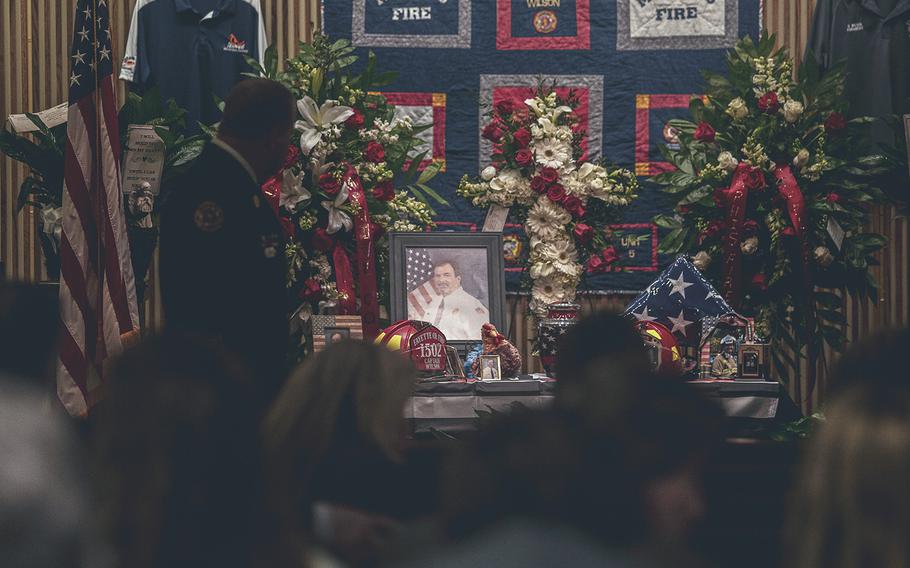
Capt. Julian Greaves Wilson Jr. died of covid-19 in January. His work as a paramedic is evident in tributes at a funeral home in Somerville, Tenn. (Andrea Morales for The Washington Post)
Stars and Stripes is making stories on the coronavirus pandemic available free of charge. See more stories here. Sign up for our daily coronavirus newsletter here. Please support our journalism with a subscription.
SOMERVILLE, Tenn. — Skill Wilson had amassed more than three decades of knowledge as a paramedic, first in Memphis and then in Fayette County. Two places that felt like night and day.
With only five ambulances in the county and the nearest hospital as much as 45 minutes away, Skill relished the clinical know-how necessary to work in a rural setting. Doing things like sedating patients to insert tubes into their airways.
But when it came to covid-19, despite more than 1 million deaths nationwide, Skill and his family felt their small town on the central-eastern side of Fayette County, with its fields of grazing cattle and rows of cotton and fewer than 200 covid deaths since the start of the pandemic, was a cocoon against the raging health emergency.
"It was a lot easier to stay away from others," his widow, Hollie Wilson, said of the largely White and predominantly conservative county of about 42,000 residents. "Less people. Less chance of exposure."
Covid seemed like other people's problems - until it wasn't.
The imbalance in death rates among the nation's racial and ethnic groups has been a defining part of the pandemic since the start. To see the pattern, The Washington Post analyzed every death during more than two years of the pandemic. Early in the crisis, the differing covid threat was evident in places such as Memphis and Fayette County. Deaths were concentrated in dense urban areas, where Black people died at several times the rate of White people.
"I don't want to say that we weren't worried about it, but we weren't," said Hollie, who described her 59-year-old husband as someone who "never took a pill." After a while, "you kind of slack off on some things," she said.
Over time, the gap in deaths widened and narrowed but never disappeared - until mid-October 2021, when the nation's pattern of covid mortality changed, with the rate of death among White Americans sometimes eclipsing other groups.
A Post analysis of covid death data from the Centers for Disease Control and Prevention from April 2020 through this summer found the racial disparity vanished at the end of last year, becoming roughly equal. And at times during that same period, the overall age-adjusted death rate for White people slightly surpassed that of Black and Latino people.
The nature of the virus makes the elderly and people with underlying health conditions - including hypertension, diabetes and obesity, all of which beset Black people at higher rates and earlier in life than White people - particularly vulnerable to severe illness and death.
That wasn't Skill.
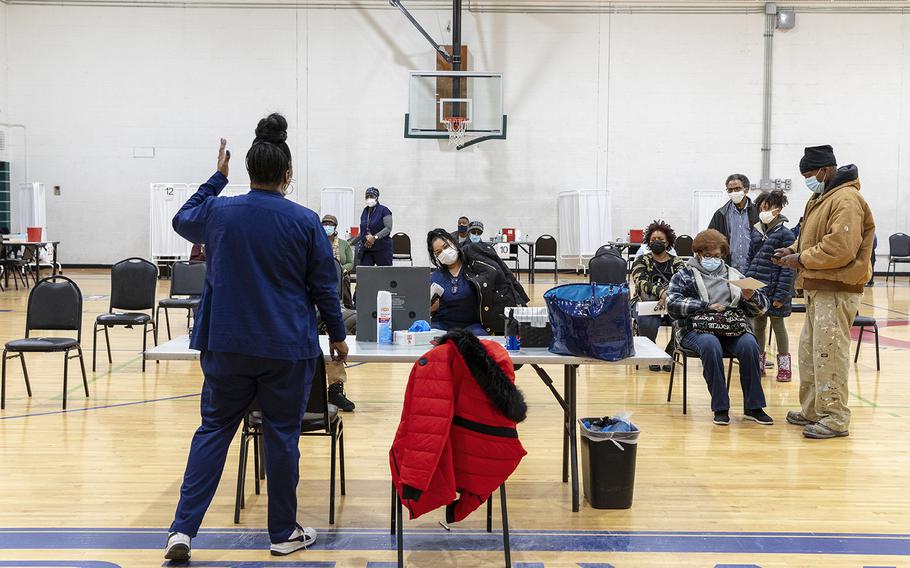
A medical professional speaks with people who just received a coronavirus vaccine in Detroit on Nov. 30, 2021. (Elaine Cromie for The Washington Post )
The virus also attacks unvaccinated adults - who polls show are more likely to be Republicans - with a ferocity that puts them at a much higher risk of infection and death.
That was Skill.
He joined the choir of critics opposing vaccination requirements, his rants in front of the television eventually wearing on Hollie, who, even if she agreed, grew tired of listening and declared their home "covid-talk free."
So, she said, Skill commiserated with like-minded people in Facebook groups and on Parler and Rumble, the largely unmoderated social networking platforms popular with conservatives.
"We're Republicans, and 100 percent believe that it's each individual's choice - their freedom" when it comes to getting a coronavirus shot, Hollie said in January. "We decided to err on the side of not doing it and accept the consequences. And now, here we are in the middle of planning the funeral."
Capt. Julian Greaves Wilson Jr., known to everybody as Skill, died of covid Jan. 23, a month after becoming infected with the coronavirus. He fell ill not long after transporting a covid patient to the hospital. At the time he died, infection rates in Fayette County had soared to 40.5 percent among people taking coronavirus tests.
'A different calculus'
When the coronavirus appeared in the United States, it did what airborne viruses do - latched onto cells in people's respiratory tract, evaded innate immune responses and multiplied. The pathogen, free of politics or ideology, had a diverse reservoir of hosts and found fertile pathways for growth in the inequalities born from centuries of racial animus and class resentments.
Unequal exposure, unequal spread, unequal vulnerability and unequal treatment concentrated harm in communities that needed protection the most yet had the least. Cumulatively, Black, Latino and Native American people are 60 percent more likely to die of covid.
But as the pandemic progressed, the damage done by the virus broadened, and the toxicity of modern-day politics came to the fore.
The Post analysis revealed the changing pattern in covid deaths. At the start of the pandemic, Black people were more than three times as likely to die of covid as their White peers. But as 2020 progressed, the death rates narrowed - but not because fewer Black people were dying. White people began dying at increasingly unimaginable numbers, too, the Post analysis found.
In summer 2021, the nation saw some of the pandemic's lowest death rates, as vaccines, shoring up the body's immune response, became widely available.
Then came the delta variant. The virus mutated, able to spread among the vaccinated. As it did, an erosion of trust in government and in medicine - in any institution, really - slowed vaccination rates, stymieing the protection afforded by vaccines against severe illness and death.
After delta's peak in September 2021, the racial differences in covid deaths started eroding. The Post analysis found that Black deaths declined, while White deaths never eased, increasing slowly but steadily, until the mortality gap flipped. From the end of October through the end of December, White people died at a higher rate than Black people did, The Post found.
That remained true except for a stretch in winter 2021-2022, when the omicron variant rampaged. The Black death rate jumped above White people's when the spike in cases and deaths overwhelmed providers in the Northeast, resulting in a bottleneck of testing and treatment.
When the surge subsided, the Black death rate once again dropped below the White rate.
"Usually, when we say a health disparity is disappearing, what we mean is that . . . the worse-off group is getting better," said Tasleem Padamsee, an assistant professor at Ohio State University who researched vaccine use and was a member of the Ohio Department of Health's work group on health equity. "We don't usually mean that the group that had a systematic advantage got worse."
That's exactly what happened as the White death rate surpassed that for Black people, even though Black Americans routinely confront stress so corrosive it causes them to age quicker, become sicker and die younger.
The shift in covid death rates "has vastly different implications for public health interventions," said Nancy Krieger, professor of social epidemiology at Harvard University's T.H. Chan School of Public Health. Officials must figure out how to connect with "communities who are ideologically opposed to the vaccine" while contending with "the cumulative impact of injustice" on communities of color.
"Think about the fact that everyone who is age 57 and older in this country was born when Jim Crow was legal," she said. "What that did was intersect with covid-19, meaning that embodied history is part of this pandemic, too."
So what contributed to the recent variation in death rates? And why?
The easy explanation is that it reflects the choices of Republicans not to be vaccinated, but the reasons go deeper. The Post interviewed historians and researchers who study the effects of White racial politics and social inequality on health, spoke with relatives and friends of those lost to covid, and compiled data from federal databases and academic studies.
What emerged is a story about how long-standing issues of race and class interacted with the physical and psychological toll of mass illness and death, unprecedented social upheaval, public policies - and public opinion.
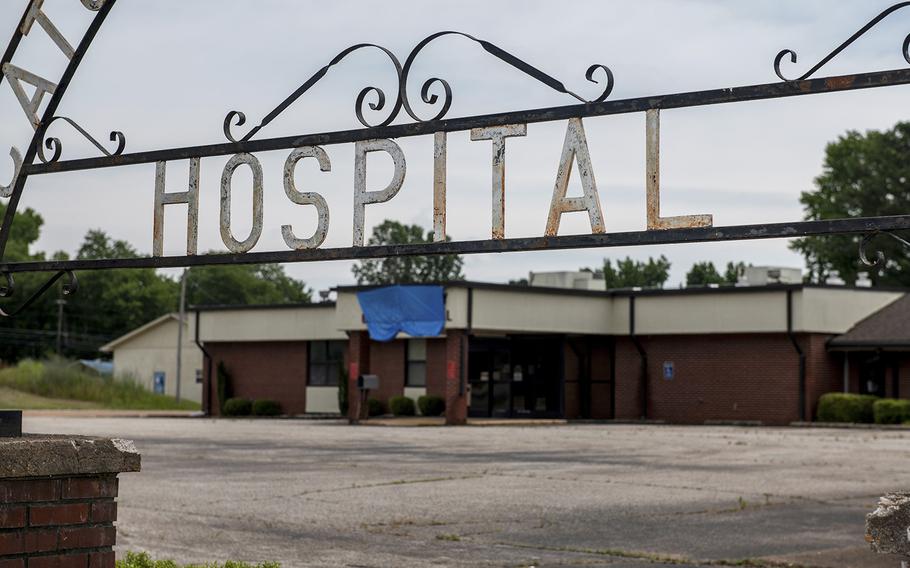
The Decatur County General Hospital in Parsons, Tenn., is among a raft of rural hospitals that have closed. (Brandon Dill for The Washington Post )
Resilience gave way to fatigue. Holes left by rural hospital closures deepened. Medical mistrust and misinformation raged. Skeptics touted debunked alternatives over proven treatments and prevention. Mask use became a victim of social stigma.
Many Republicans decided they would rather roll the dice with their health than follow public health guidance - even when provided by President Donald Trump, who was booed after saying he had been vaccinated and boosted.
Researchers at Ohio State found Black and White people were about equally reluctant to get the coronavirus vaccine when it first became available, but Black people overcame that hesitancy faster. They came to the realization sooner that vaccines were necessary to protect themselves and their communities, Padamsee said.
As public health efforts to contain the virus were curtailed, the pool of those most at risk of becoming casualties widened. The No. 1 cause of death for 45-to-54-year-olds in 2021 was covid, according to federal researchers.
"I still remember when I was doing the mayor's press conferences a few months into this, and I made note of the fact that most of those people who had died look like me," said James E.K. Hildreth, president and CEO of Meharry Medical College, one of the nation's oldest and largest private, historically Black academic health sciences center, in Nashville. Hildreth played a central role in the city's pandemic response.
"I wondered aloud if it were reversed, would the whole nation not be more galvanized to fight this thing?" recalled Hildreth, an immunologist and member of an expert panel that advises the Food and Drug Administration on vaccines, including coronavirus shots.
After it became clear that communities of color were being disproportionately affected, racial equity started to become the parlance of the pandemic, in words and deeds. As it did, vaccine access and acceptance within communities of color grew - and so did the belief among some White conservatives, who form the core of the Republican base, that vaccine requirements and mask mandates infringe on personal liberties.
"Getting to make this decision for themselves has primacy over what the vaccine could do for them," said Lisa R. Pruitt, a law professor at the University of California at Davis who is an expert in social inequality and the urban-rural divide. "They're making a different calculus."
It's a calculation informed by the lore around self-sufficiency, she said, a fatalistic acceptance that hardships happen in life and a sense of defiance that has come to define the modern conservative movement's antipathy toward bureaucrats and technocrats.
"I didn't think that that polarization would transfer over to a pandemic," Pruitt said.
It did.
A lifesaving vaccine and droplet-blocking masks became ideological Rorschach tests.
The impulse to frame the eradication of an infectious disease as a matter of personal choice cost the lives of some who, despite taking the coronavirus seriously, were surrounded by enough people that the virus found fertile terrain to sow misery. That's what happened in northern Illinois, where a father watched his 40-year-old son succumb to covid-19.
For Robert Boam, the increase in White deaths is politics brought to bear on the body of his son, though he's reluctant "to get into the politics of it all, but it all goes back to that."
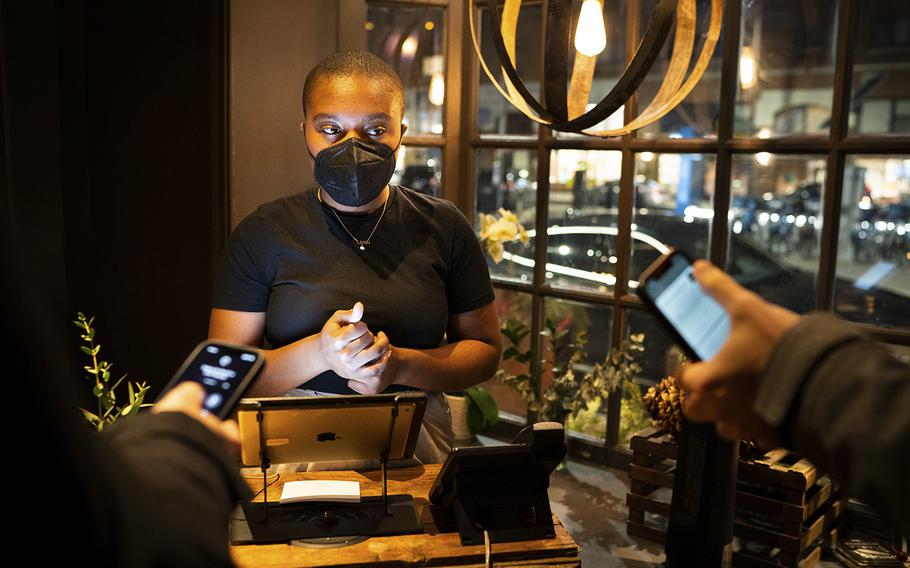
Hostess Khaliah Corley checks vaccination cards at a Philadelphia restaurant in February 2022. (Sarah L. Voisin/Washington Post)
Brian Boam was a PE teacher at an elementary school in suburban Chicago. On Christmas Eve, the entire family gathered at the elder Boam's home in an Illinois town where the first Lincoln-Douglas debate was held. Brian Boam was there with his 10-year-old daughter and 6-year-old son.
Robert Boam said his son had survived covid the year before, so "we got on his butt to get that booster shot when he was here for Christmas." And he did - but got sick again, the 73-year-old said. "Being vaccinated, and all that, and getting covid again kind of bummed him out."
Just after the new year, Brian Boam, who was hypertensive, went to a hospital feverish and vomiting. It took 10 hours to be seen and even longer for a bed to become available. As he waited, he sent what would be his last text message to his parents. Thanks for all you do. I love you.
He went into cardiac arrest in the emergency room and was transferred to Rush University Medical Center in Chicago, one of the nation's top academic hospitals. There, his family hoped he would be healed, but his organs began to fail. He died Jan. 8.
"The thing that gets me is the people who still don't believe it's serious or even real, but when they get sick, they run to the hospital," Robert Boam said. "You're taking away from heart attack patients and stroke patients."
The pandemic, he said, "should've been taken seriously from the very beginning, and it wasn't. It was denied. It was downplayed. And it all goes back to one person, as far as I'm concerned."
Asked who that was, Boam would say only: "I'll give you three guesses. The first two don't count."
Stress, and its burden
While almost three years of chaotic public health crises have left Americans of all races uncertain about the future, they have also revealed the enduring nature of racial and class politics - and the cost they exact, including for White Americans.
Those triggers are layered upon each other, stoking stress, said Derek M. Griffith, who co-leads the Racial Justice Institute and directs the Center for Men's Health Equity at Georgetown University.
"Whether it's 'I can't pay my rent and mortgage as easily as I used to,' or 'I want to show I'm not worried about covid,' your body doesn't care where the stress is coming from. It's just experiencing stress," he said. "Then add to that how people are coping with the stress."
When it comes to racism, most people think of something that occurs between individuals. But it's as much about who has access to power, wealth and rights as it is about insults, suspicion and disrespect. Prejudice and discrimination, even if unconscious, can be deadly - and not just for the intended targets.
A growing body of research, outlined in the book "Caste," by Isabel Wilkerson, shows that even the most anodyne of social exchanges with people of different races, such as glancing at faded yearbook photos, can raise White people's blood pressure and cortisol levels.
Stress is a hard-wired physiological response, triggered at the first sign of danger. The brain sounds an alarm, setting off a torrent of neurological and hormonal signals. Persistent surges of cortisol and other stress hormones can wear down the body, increasing the risk of stroke, diabetes, heart attack or premature death by damaging blood vessels and arteries. Overexposure to stress can weaken the immune response and can make it harder to develop antibodies after being vaccinated against infectious diseases.
Sometimes, the harm is not just biological but also behavioral.
Researchers at the University of Georgia found that White people who assumed the pandemic had a disparate effect on communities of color - or were told that it did - had less fear of being infected with the coronavirus, were less likely to express empathy toward vulnerable populations and were less supportive of safety measures, according to an article in Social Science & Medicine.
Perhaps, the report concludes, explaining covid's unequal burden as part of an enduring legacy of inequality "signaled these disparities were not just transitory epidemiological trends, which could potentially shift and disproportionately impact White people in the future."
Translation: Racial health disparities are part of the status quo.
And because of that, government efforts to bring a public health threat to heel are seen by some White Americans as infringing on their rights, researchers said.
"This is reflective of politics that go back to the 19th-century anxieties about federal overreach," said Ayah Nuriddin, a postdoctoral fellow at Princeton University who studies the history of medicine.
Us vs. them
Questions about the government's role in ensuring the public's health and well-being hang heavy with historical inflections in states such as Tennessee, once home to the president who argued that Reconstruction-era legislation to help and protect newly freed enslaved people violated states' rights.
And so in many ways, the roots of the consternation over recent pandemic-control measures began sprouting a century and a half earlier.
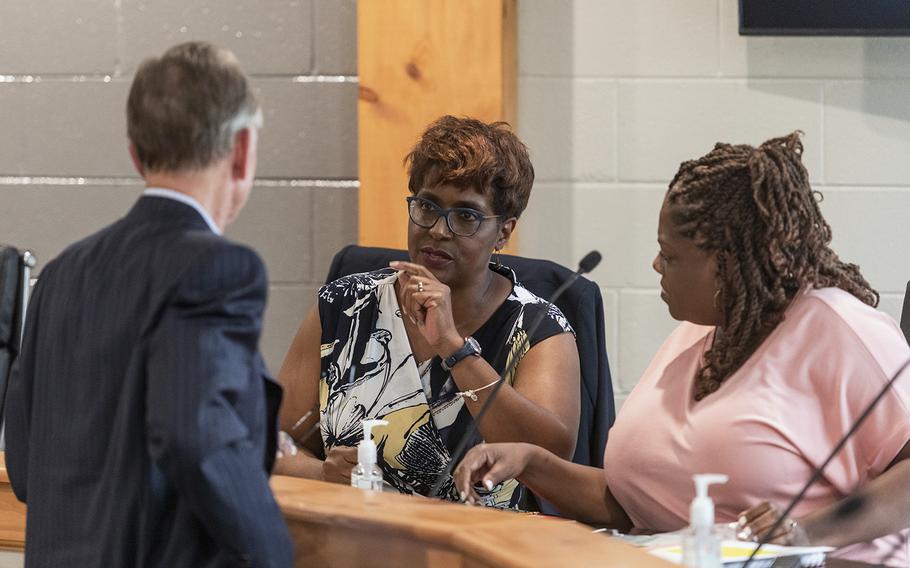
Civil Miller-Watkins, center, attends a meeting of the Fayette County Board of Education on June 2 in Somerville, Tenn. (Brandon Dill for The Washington Post )
But that hasn't stopped people such as Civil Miller-Watkins from wondering why those roots are choking so many now.
The former Fayette County school board member, who possesses an abiding belief in the power of the common good, said she finds the mind-set "I know what's good for me, and if it's harmful for you, you're going to have to deal with it" worrisome amid a pandemic.
"Living in a rural county is not for the faint of heart, especially as a Black person," the 56-year-old said. Still, she can't help but wonder, "if I'm the same neighbor you give sugar to, and you know I have an 84-year-old in my house and a little-bitty baby at home, why wouldn't you wear a mask around me?"
It's a question that dogged her over Christmas when two of her grandchildren were infected with the coronavirus days before they were scheduled to be vaccinated.
"We put it on Republicans and politics," she said, "but I think we should dig deeper."
That's what Jonathan M. Metzl, director of Vanderbilt University's Department of Medicine, Health, and Society, did for six years while researching his book "Dying of Whiteness: How the Politics of Racial Resentment is Killing America's Heartland."
Published in 2019, it is a book about the politicization of public health and mistrust of medical institutions. It is a story about how communal values take a back seat to individuality. It's an exploration of disinformation and how the fear of improving the lives of some means worsening the lives of others.
"I didn't know it at the time, but I was writing a prehistory of the pandemic," Metzl said in an interview. "You're seeing a kind of dying-of-Whiteness phenomenon in the covid data that's very similar to what I saw in my data."
Metzl and Griffith, a Vanderbilt professor at the time, conducted focus groups on the Affordable Care Act throughout middle Tennessee including White and Black men who were 20 to 60 years old. Some were small-business owners and security guards. Others were factory workers and retirees.
The divergent medical experiences of Black and White patients permeated Metzl's focus groups, particularly when the conversation veered toward the politics of health and government's role in promoting well-being.
"Black men described precisely the same medical and economic stressors as did White men and detailed the same struggles to stay healthy," Metzl wrote. "But Black men consistently differed from White men in how they conceived of government intervention and group identity. Whereas White men jumped unthinkingly to assumptions about 'them,' Black men frequently answered questions about health and health systems through the language of 'us.' "
Tennessee has yet to expand Medicaid under the ACA, a decision fueling rural hospital closures at a rate that eclipses nearly every other state because there isn't enough money to keep the doors open. Not only would expanding Medicaid have saved hospitals, Metzl wrote, it would have saved thousands of lives - White and Black.
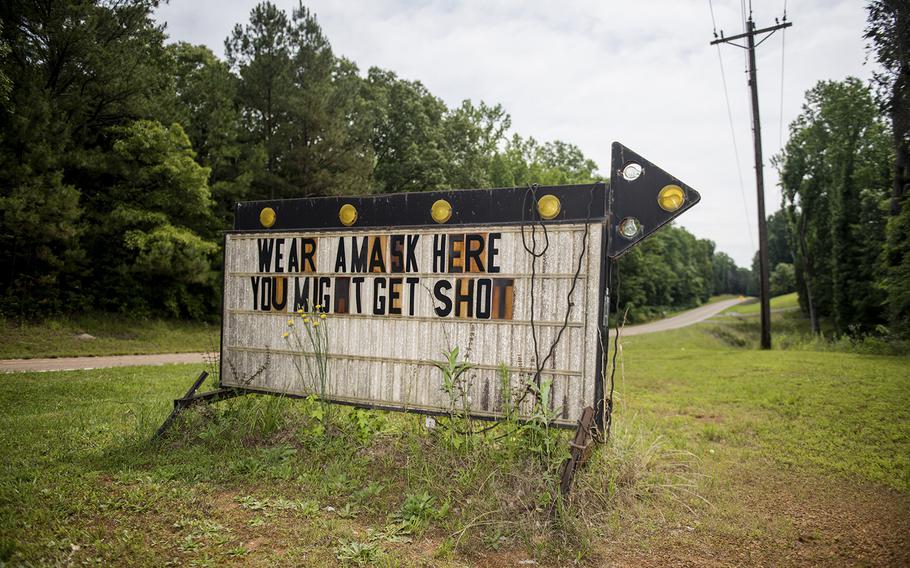
The message was unmistakable outside a business in Reagan, Tenn., on June 6, 2022. (Brandon Dill for The Washington Post )
Metzl said watching the pandemic unfold felt like a flashback to past battles over federal health-care reform. Messaging that leaned into quantitative data about masks and vaccines sounded eerily similar to the mistakes made, "at least for this part of the country," with the ACA, he said.
"The minute public health infrastructure started to talk about the statistical public health benefits of the mask" and not how everyone needed to be on the same page to stay safe, Metzl said, "I just knew that it was going to open a door for the same kind of anti-ACA stuff, which is 'the government's telling you what to do.' "
As Metzl conducted research for his book in 2016, a 41-year-old uninsured Tennessean named Trevor who was jaundiced and in liver failure told him "I would rather die" than sign up for the ACA. When asked why, Trevor, who was identified by first name only, said: "We don't need any more government in our lives. And in any case, no way I want my tax dollars paying for Mexicans or welfare queens."
Now during the pandemic, there are people like 39-year-old Chad Carswell of North Carolina whose kidneys functioned recently at just 3 percent. He was denied a new kidney in January after refusing to take a coronavirus vaccine as required for the transplant at the time, saying: "I was born free. I'll die free."
Much like protests to "repeal and replace" the ACA, Metzl said rejecting public health measures is about dogma more so than a mistrust of the science of vaccines or masks.
"We've oversimplified this with morality tales about the vaccine is good, and anti-vaxxers are bad, and they're automatically racist," Metzl said. "Being anti-vaccine or anti-mask is part of an ideology. When people get more desperate, they get more ideological."
A funeral, a cause
Skill Wilson's funeral in January was a public testimony to the complexity of people. The room was draped in the unmistakable symbols of patriotism, a steely declaration that this was someone who believed in service and sacrifice for country and community. Firefighters sat in row upon row, their dress uniforms - crisp white shirts and formal blue blazers - marking the solemn occasion. Maskless faces abounded.
His urn, embossed with the firefighters' "thin red line" flag - a black-and-white U.S. flag with a single red stripe across it - sat between two firemen's helmets. It is a flag that some have come to see as a political statement, while others view it as a way to honor fallen firefighters. Behind them, a burial flag folded into a crisp triangle.
A succession of eulogies told the story of a man who could make you drive past your highway exit in a fit of rage, who harassed the fire chief until every station in the county had a flagpole that displayed the Stars and Stripes, who loved sneaking up behind his children and yelling, "Boo!"
Husband. Father. Friend.
Sarcastic. Goofy. Joker.
"Skill was one of the constants in my life. For people who didn't really know our friendship, they'd think we hated each other," said Debbie Patterson, a division chief with Emergency Medical Services at the Memphis Fire Department. "We were constantly going to battle and name-calling. Some of them are dork, idiot, slacker. But our true term of endearment for each other, for years, has been 'b----es.' "
He would call at 6 a.m., even when she wasn't on shift, to "wake me up and tell me I was a slacker for being on vacation," she said, laughing.
During those phone calls, they figured out the day's menu for lunch, bragged about their children and personal lives, and solved the fire department's problems "as firefighters do."
"Of course, we rarely saw eye to eye on anything," she said. "The best part about Skill was he could laugh at himself for being a dumb ass, too."
It was a scene of mourning and hope, of bravado and brokenness. There was as much laughter as sorrow, wounds healed by scripture and classic '70s rock. It was a paragon of Southern, White masculinity.
Last to the lectern was Hollie's uncle, who looked out at the sea of uniforms, at the men and women in government service, and assured them that the uncomfortable truths he said he was about to share were not directed at anybody in the room.
Skill, he said, was a warrior who put his faith in the system that "betrayed him and left him laying on this battlefield" during a "war he was willing to fight."
"How many more good men and women - fathers, brothers, mothers and sisters - will be sacrificed on the altar of money before we all stand up and say this is enough?" he continued, adding that "Skill and I were on the same page. We had the same worldview."
He never specified the war, though he said it was one we're all fighting "no matter what lines they try to draw between us." Faith, he said, lies with God and each other, "not in those who are solely motivated by profit."
But it wasn't about what he said. It was about what he left unsaid: the far-right extremist views that go beyond the bounds of traditional conservative politics and ideals of patriotism.
Online, he and the family have shared social media posts and, until recently, sold customized insulated plastic cups bearing the insignia of Three Percenters, a decentralized militant movement named after the myth that just 3 percent of the population fought the British in the American Revolution. It's founded on the idea that armed "patriots" should protect Americans from the tyranny of big government, including gun laws, pandemic shutdowns and racial justice protests.
Later, outside in the parking lot while smoking a cigarette, Hollie's uncle clarified that the battle is against covid and shared the popular - yet false - conspiracy that potentially lifesaving covid medications are being withheld by the health-care system. What he wouldn't do was provide his name, saying he didn't want "little black SUVs showing up at my house."
Methodology
The Post applied the standard technique used by the Centers for Disease Control and Prevention to calculate age-adjusted covid death rates by race using the CDC's provisional covid death data that includes race, ethnicity, age and date of death. Under that procedure, The Post calculated death rates for age groups by dividing the number of deaths by the population in that age group. The Post then used a standardized age distribution to create an overall rate for each race-ethnicity group.
Age-adjusted rates are especially necessary for understanding covid deaths because the majority of people killed by covid are age 75 or older, even though that group represents less than 9 percent of the U.S. population. Additionally, more than 90 percent of covid deaths are in people age 50 and older.
The covid death age pattern is important in reviewing deaths by race because White people are disproportionately older. More than 40 percent of White people are age 50 or older, but less than 30 percent of Black people are in those older age groups. Hispanics are even younger, with less than 25 percent age 50 or older.
The age-adjusted rates offset that difference in age distribution to compare deaths as if the races or ethnic groups had the same age distribution.
Whites, Blacks, Asians, American Indians and Alaskan Natives are non-Hispanic. Hispanics are of any race, so the racial groups and the Hispanic groups do not overlap.
For maps, The Post calculated age-adjusted covid death rates for each race in each state over the course of the pandemic using provisional covid death data by state.